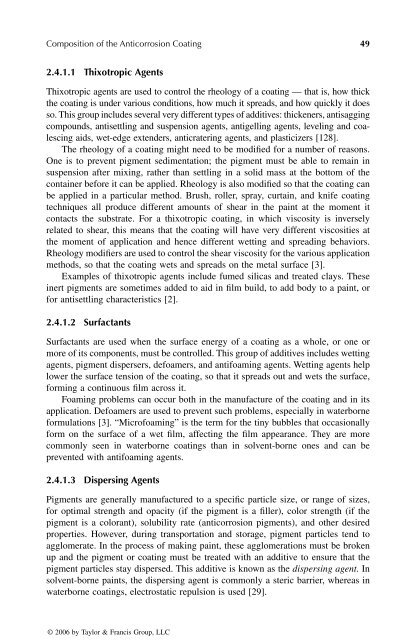© 2006 by Taylor & Francis Group, LLC
© 2006 by Taylor & Francis Group, LLC
© 2006 by Taylor & Francis Group, LLC
Create successful ePaper yourself
Turn your PDF publications into a flip-book with our unique Google optimized e-Paper software.
Composition of the Anticorrosion Coating 49<br />
2.4.1.1 Thixotropic Agents<br />
Thixotropic agents are used to control the rheology of a coating — that is, how thick<br />
the coating is under various conditions, how much it spreads, and how quickly it does<br />
so. This group includes several very different types of additives: thickeners, antisagging<br />
compounds, antisettling and suspension agents, antigelling agents, leveling and coalescing<br />
aids, wet-edge extenders, anticratering agents, and plasticizers [128].<br />
The rheology of a coating might need to be modified for a number of reasons.<br />
One is to prevent pigment sedimentation; the pigment must be able to remain in<br />
suspension after mixing, rather than settling in a solid mass at the bottom of the<br />
container before it can be applied. Rheology is also modified so that the coating can<br />
be applied in a particular method. Brush, roller, spray, curtain, and knife coating<br />
techniques all produce different amounts of shear in the paint at the moment it<br />
contacts the substrate. For a thixotropic coating, in which viscosity is inversely<br />
related to shear, this means that the coating will have very different viscosities at<br />
the moment of application and hence different wetting and spreading behaviors.<br />
Rheology modifiers are used to control the shear viscosity for the various application<br />
methods, so that the coating wets and spreads on the metal surface [3].<br />
Examples of thixotropic agents include fumed silicas and treated clays. These<br />
inert pigments are sometimes added to aid in film build, to add body to a paint, or<br />
for antisettling characteristics [2].<br />
2.4.1.2 Surfactants<br />
Surfactants are used when the surface energy of a coating as a whole, or one or<br />
more of its components, must be controlled. This group of additives includes wetting<br />
agents, pigment dispersers, defoamers, and antifoaming agents. Wetting agents help<br />
lower the surface tension of the coating, so that it spreads out and wets the surface,<br />
forming a continuous film across it.<br />
Foaming problems can occur both in the manufacture of the coating and in its<br />
application. Defoamers are used to prevent such problems, especially in waterborne<br />
formulations [3]. “Microfoaming” is the term for the tiny bubbles that occasionally<br />
form on the surface of a wet film, affecting the film appearance. They are more<br />
commonly seen in waterborne coatings than in solvent-borne ones and can be<br />
prevented with antifoaming agents.<br />
2.4.1.3 Dispersing Agents<br />
Pigments are generally manufactured to a specific particle size, or range of sizes,<br />
for optimal strength and opacity (if the pigment is a filler), color strength (if the<br />
pigment is a colorant), solubility rate (anticorrosion pigments), and other desired<br />
properties. However, during transportation and storage, pigment particles tend to<br />
agglomerate. In the process of making paint, these agglomerations must be broken<br />
up and the pigment or coating must be treated with an additive to ensure that the<br />
pigment particles stay dispersed. This additive is known as the dispersing agent. In<br />
solvent-borne paints, the dispersing agent is commonly a steric barrier, whereas in<br />
waterborne coatings, electrostatic repulsion is used [29].<br />
<strong>©</strong> <strong>2006</strong> <strong>by</strong> <strong>Taylor</strong> & <strong>Francis</strong> <strong>Group</strong>, <strong>LLC</strong>
















